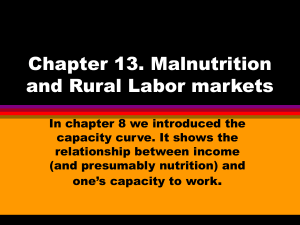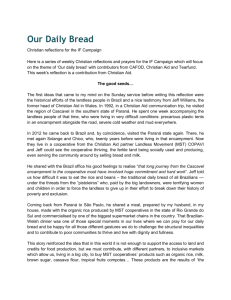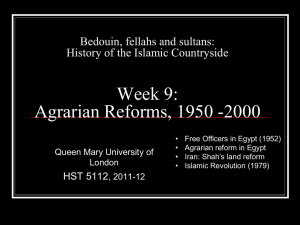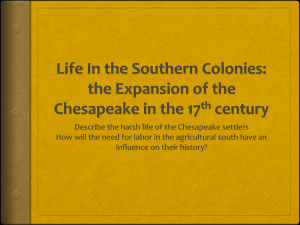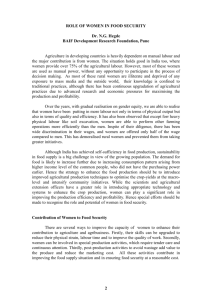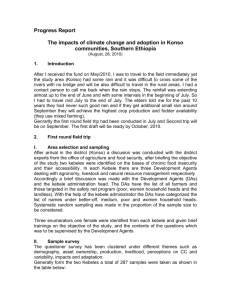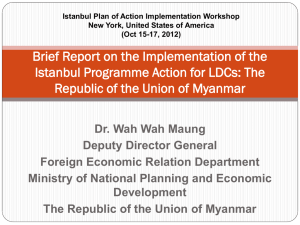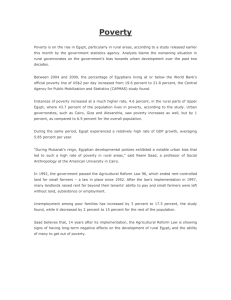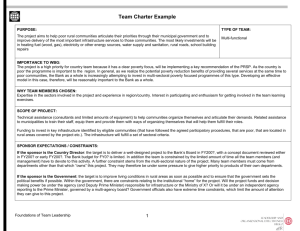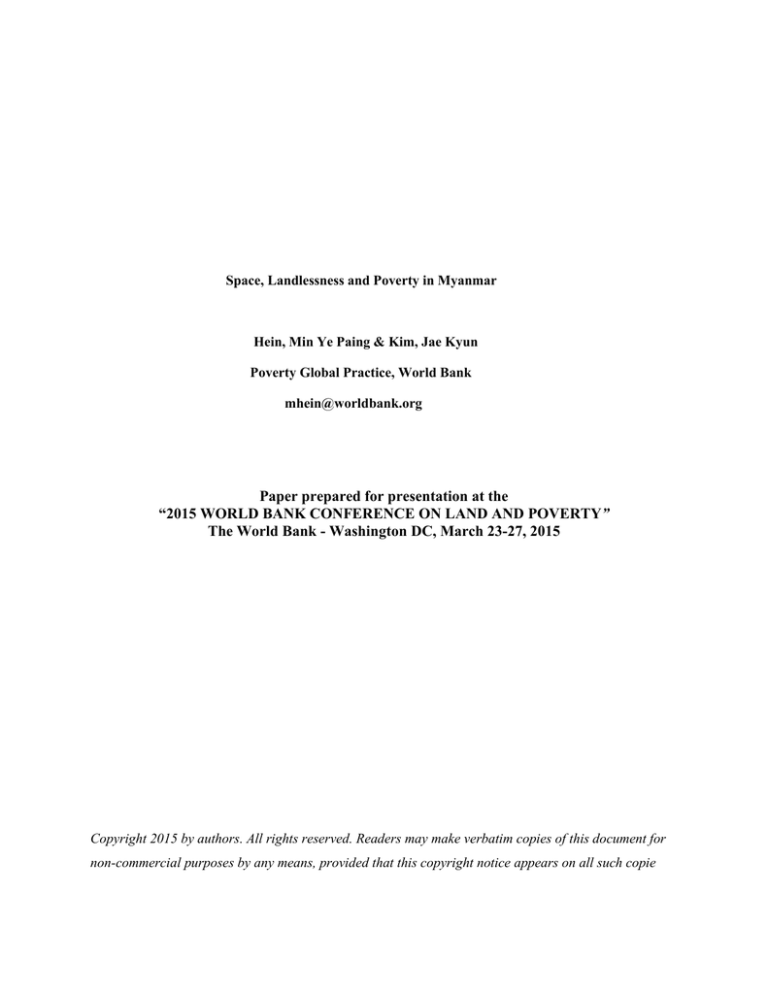
Space, Landlessness and Poverty in Myanmar
Hein, Min Ye Paing & Kim, Jae Kyun
Poverty Global Practice, World Bank
mhein@worldbank.org
Paper prepared for presentation at the
“2015 WORLD BANK CONFERENCE ON LAND AND POVERTY”
The World Bank - Washington DC, March 23-27, 2015
Copyright 2015 by authors. All rights reserved. Readers may make verbatim copies of this document for
non-commercial purposes by any means, provided that this copyright notice appears on all such copie
Abstract
This paper examines the intersection between landlessness and poverty in Myanmar through the lens of
spatial and labor dynamics. This paper employs a plethora of data sources including national household
surveys such as Integrated Household Living Condition Survey (UNDP, 2010), regional survey such as
the LIFT baseline survey (LIFT, 2013), Dry Zone Survey (JICA, 2010) as well as qualitative reports from
Qualitative Social and Economic Monitoring (World bank, 2012) to unpack the commonalities as well as
spatially distinct characteristics of landless and casual labor across four different agro-ecological zones in
Myanmar such as the delta, coastal, dry zone and the hilly region. The paper shows that socio-economic
profiles of the landless and causal labor are not monochromatic and there are both qualitative and
quantitative differences in the characteristics and contours of deprivation based on the specific location of
the landless. For example, urban poor are most often better off than both rural poor and non-poor across
multiplicity of welfare indicators. The paper also finds that casual laborers are the poorest of the poor
nesting at the nadir of myriad welfare indicators through a systematic comparison between the landless
and casual labors across Myanmar. Lastly, the paper identifies three major factors behind the increase in
landless and casualization of labor in Myanmar.
Key Words: Land, Casual Labor, Poverty, Myanmar, climatic change.
Introduction
Landlessness is a highly politicized issue in Myanmar and has received some scholarly attention
in recent years (Dapice et al, 2009 2010 2011) (MSU/MRDI, 2013). However, Landlessness is not a
monolithic phenomenon and myriad paths lead to landlessness. There may be some intimate connection
between landlessness and poverty in Myanmar as suggested by existing studies. But one suspects some
nuances and complexities in the purported intimacy between landlessness and poverty. In that spirit of
unpacking the complexities and contours of landlessness, this paper is an attempt to present a systematic
account of landlessness and poverty in Myanmar.
Data Landscape on Landlessness in Myanmar: Big and Small Data
Integrated Household Living Condition (IHCLA) surveys, conducted by the Ministry of National
Planning and Economic Development and the UNDP in 2004/2005 and 2009/201, are the only nationally
representative household surveys with information on a wide spectrum of poverty and welfare indicators
as well as landlessness on a national level. In recent years, the World Bank poverty team revisited the
IHLCA second round (IHLCA II) and generated a revised poverty profile based on regionally-anchored
price adjustments and a wider welfare aggregates for poverty estimates. Therefore, this paper will
primarily draw upon the revised IHLCA II data in constructing and comparing national and regional
profiles of landless and characteristics of landless poor. In contrast, regionally specific information on
landless and welfare can also be gleaned through smaller household surveys such as the LIFT baseline
Survey and JICA Dry Zone study. The LIFT (Livelihood and Food Security Trust Fund) baseline survey
covered 4,000 households in the LIFT-operated villages in three agro-ecological zones such as Hilly,
delta/coastal and Dry Zone as well as control villages. In the same vein, the Qualitative Social and
Economic Monitoring (QSEM) study of the World Bank also collects and compiles qualitative
information on the livelihood of the households in three ecological zones (Hilly, Coastal and Dry zone)
with which the LIFT consortium has operations. On the other hand, the JICA study offers an in-depth
quantitative analysis of the landless based on 419 households in seven villages in the Central Dry Zone
including Sagaing, Magway and Mandalay regions. This paper will juxtapose all these extant quantitative
and qualitative studies to construct and compare national and subnational profiles of landlessness and
poverty in Myanmar.
Landlessness and Poverty in Myanmar
According to the IHLCA revised data, national estimate for landlessness rate is around 56 percent
for Myanmar. If we were to restrict our sample to rural landlessness in in Myanmar, the prevalence rate
declines to approximately 43 percent, which finds its resonance in the estimate of 40.1 percent given by
the UNDP/FAO study in 2004 (JICA, 2010 P.3-40). The data further indicates that the delta zone has the
highest rate of rural landlessness with 57.71 percent and the coastal zone is a close second with 56
percent. In the dry zone, rural landlessness revolves around 39 percent (the JICA study based on a small
sample estimate that landless rate in the Central Dry zone would fall around 42 percent and the QSEM
study by the World Bank (2012) estimates that half of the households in the Dry Zone and Rakhine in the
coastal zone are landless) while the hilly region enjoys the lowest rural landlessness rate of 23 percent.
Also, the ordinal ranking of ecological zones based on the IHLCA II revised data is consistent with the
ranking given by the LIFT baseline survey in 2012. In terms of the concentration of rural landless
amongst four regions, the dry zone alone accounts for 44 percent of the entire rural landless population
while 28 percent of the remaining rural landless population is concentrated in the delta. Therefore, these
two regions alone account for seventy two percent of the entire rural landless population. Twenty percent
of rural landless population can be found in the coastal region and another eight percent of the landless
are concentrated in the hilly region.
For the entire landless population, twenty four percent of the population suffers from extreme
poverty and forty two percent falls under the poverty line as shown in the figure (1). The incidence of
extreme poverty (food poverty) amongst urban landless is low (14.4 percent) while such incidence for
rural landless is relatively higher with 32.5 percent. With 42.48 percent of the landless under the food
poverty line, the landless in the coastal region suffers from the highest extreme poverty rate in all the
agro-ecological zones. The dry zone and the delta have similar food poverty incidence rates around 22
percent while the hilly region, with 16.44 percent of food poor amongst the landless, has the lowest food
poverty incidence. For the urban landless, poverty incidence rate is 34.6 percent and for the rural landless,
it is 47.1 percent. As with the case of food poor, the coastal region still has the highest poverty rate
amongst all the agro-ecological zones with approximately 59 percent of its landless population below the
poverty line, albeit it only contains twenty percent of the entire landless poor population in Myanmar.
The delta, with 48 percent poverty rate and 38 percent population share of the poor amongst the landless,
has the highest population share of the poor within the landless population. It is interesting to note that
the dry zone has the second highest share of the poor amongst the landless (thirty two percent) although
its incidence rate for the landless is the third lowest amongst (35.63) all the ecological zones. Thus, these
two ecological zones account for 72 percent of the landless and 73.6 percent of the poor amongst the
landless. On the other end of the spectrum, the hilly zone has the lowest poverty incidence rate and lowest
share of the poor amongst the landless.
Profiles of the landless in Myanmar
On the national level, the educational attainment of the landless is very low. As shown in the
figure 2, fifty seven percent of the landless have either received no formal education or only completed
primary school. Conversely, only five percent of the landless have graduated from the university. Ethnolinguistic profile of the landless based on the IHLCA revised data (using mother tongue of the respondent
as a proxy for ethno-linguistic identity) shows that Myanmar native speakers constitute the majority of the
landless population accounting for 81 percent of the entire population whereas Rakhine native speakers,
with 4.4 percent of the population, are the second largest ethno-linguistic group in the population. Other
foreign language speakers are the third largest group with 4.13 percent of the population, followed by
Shan native speakers (2.58), Kayin native Speaker (2.06 percent) Mon native speakers (1.68 percent) and
other indigenous language speakers (1.13 percent). In terms of religious affiliations of the landless, the
Buddhists account for the majority of the landless population (87.14 percent) whereas the Muslim
constitutes the second largest religious group with 8.55 percent of the landless while making up for 5.82
percent of the entire population. Christians are the third most represented group amongst four major
religions in Myanmar with 3.69 percent of the landless population.
Housing conditions for the landless in Myanmar speak to the extent of vulnerability of this group.
More specifically, seventy two percent of the landless have non-durable external wall materials such as
Thatch/ large leaves/ Palm/ denee, Bamboo and rudimentary wood and seventy nine percent of the
landless have non-durable floor materials such as earth/sand, Wood planks, Palm/ Bamboo and
combination of these materials. The LIFT baseline survey also corroborates this narrative of household
vulnerability for the landless given by the IHLCA II since approximately seventy nine percent of the
landless households have palm frond/thatch as roofing materials whereas only forty five percent of the
landed households have similar housing materials. Around twenty nine percent of the landless are relying
on unprotected water sources such as unprotected hand-dug-well/spring/pond/river/lake/spring as the
main source of water for the household as the major source of their households. Furthermore, the data
indicates that thirteen percent of the landless depends on unsanitary toilet facilities such as bucket/pan,
surface latrine and open pit as well as having no access to any toilet facilities. Public electricity is the
main source of lighting for forty percent of the landless and twenty percent of the landless reply on candle
for lighting the households. Kerosene and private electricity are the third and fourth most frequently
occurring sources of lighting amongst the landless. The use of electricity as the source of fuel is very
limited amongst the landless and only seven percent of the landless are using electricity as the major
source of fuel. The majority of the landless are using firewood and charcoal as their major sources of fuel
in the household.
According to the data from the IHLCA II, the bulk of the landless (specifically those did not
respond to the question on the source of major income as “non-applicable” since around fifty four percent
of the respondents answered “non-applicable” to this question) are concentrated in two major sectors in
Myanmar- Agriculture and the wholesale/retail trade. The rest of the landless are primarily dispersed in a
few other sectors such as the service sector known in the survey as “other community, social and personal
services”, manufacturing, transport, construction, and fishing sectors. In terms of occupational
distribution, there are three distinct groups- elementary occupations, skilled agriculture and modern
professionals (including legislators, professionals, Technicians and associate professionals, Clerks,
Services workers, shop and market sales workers). Out of 45.4 percent with listed occupations in the
entire sample (54.6 percent answered “non-applicable”), 18.38 percent can be categorized as modern
professionals and they constitute the majority of all listed occupations. Elementary occupations are the
second most concentrated occupations with 14.25 percent of the landless. Skilled agriculture is the third
most concentrated occupation group with 6.6 percent of the landless.
As argued previously in the paper, there may be a variety of landlessness in Myanmar. The data
shows that landlessness in the urban area is qualitatively very different from landlessness in the rural area.
Figure 3 illustrates that urban landless are better-educated than rural landless. In the rural area, 73 percent
of the landless are concentrated in two lowest strata in the echelon of Myanmar education system (i.e., no
educational qualification and primary education). In comparison, only thirty six percent of the urban
landless belong to these two strata. Moreover, a woefully negligible 1.62 percent of the rural landless
have completed their university education whereas around 11 percent of the urban landless have reached
similar level of educational attainment.
The qualities of housing for rural and urban landless are also vastly different. For example, only
fifty four percent of urban landless rely on non-durable materials for the external well of the dwelling
compared to 86 percent of the rural landless. In the same vein, sixty one percent of the urban landless
have non-durable floor materials for the dwelling whereas 91.5 percent of the rural landless have similar
floor materials for their dwellings. “Private tap inside the dwelling” and “commercial water bottle” are
the two most common source of water for the urban landless and they account for sixty percent of the
total usage. In contrast, these two sources only account for twenty one percent of all listed water sources
for rural landless and less than one percent of the rural landless claimed commercial bottled water as their
main source of water. In the same vein, only three percent of urban landless have unsanitary toilet
facilities whereas approximately twenty percent of rural landless are availing themselves of unsanitary
facilities amongst which nine percent have no access to any type of toilet facilities at all.
Electrification rate for rural landless is abysmally low compared to urban landless. Around 78
percent of the urban landless are connected to the public grid and around 89 percent of them have access
to some form of electricity via public, private or communal sources. Only seven percent of them have
listed candle as their main source of lighting. In contrast, around 57 percent of rural landless have listed
candle and kerosene as their main source of lighting and only 12.15 percent are connected to the public
grid although additional fifteen percent have access to privately generated electricity for their lighting.
Charcoal is the most common source of fuel for urban landless whereas 85.57 percent of rural landless are
using firewood as their main source of fuel.
We find the diminished role of agriculture between urban and rural as well as poor and non-poor
in both areas. For example, only one percent of the urban landless claim that agriculture, hunting and
forestry as their main source of income compared to twenty percent of the rural landless. Similarly,
amongst rural landless, the percentage in agriculture is higher for the poor than the non-poor. As with the
rural landless, the percentage employed in agriculture amongst urban poor is higher than that for urban
non-poor. One must note that more than half of the respondents answer “non-applicable” to this question.
Therefore, one must be careful with the interpreting the results given the validity of this question.
However, this variable is the only source of nationally representative information on the distribution of
the landless across sectors and occupations. On a different note, the wholesale and retail trade is the most
commonly listed major source of income for the urban landless followed by services, transport,
manufacturing, services, construction and education. Although rural landless are also represented in these
aforementioned sectors, the magnitude of their representation is significantly lower than the percentage
shares of the urban landless in these sectors.
Likewise, more than half of the urban respondents
(excluding those responded as “not applicable”) belong to modern professions such as services,
legislators, clerks and technicians while approximately 65 percent of the rural respondents belong to
either elementary occupations or skill agriculture and fishery workers. It is also interesting to note that in
the entire rural economy, around 76 percent of the respondents answered “skilled agriculture” and
“elementary occupations” while only seven percent of urban respondents belong to these corresponding
categories. “Non-farm investment” is listed as the most common reason for borrowing the last loans for
urban respondents whereas fifty percent of the last loans for the rural landless are used to finance current
consumption.
There are significant differences between urban and rural landless in terms of human capital
stock. As shown in the figure 4, only 0.51 percent of the urban landless poor have completed their
university education as opposed to 14.6 percent amongst the urban landless non-poor. On the other hand,
those with high school and above education credentials constitute 42.43 percent of the urban landless non-
poor whereas those with similar educational attainment comprise only 2.87 percent of the rural landless
poor population. Therefore, low educational attainment amongst the rural landless poor stand in sharp
contrast to the much higher educational attainment amongst the urban landless non-poor. Despite their
common standing vis-à-vis the poverty line, it is also interesting to note that educational attainment
amongst rural landless poor is considerably lower than that of urban landless poor.
Depending on the indicators, the qualities of life for rural landless on both side of the poverty line
can most often be worse off than those of the urban landless poor. Figure 5 compares the differences in
the performance of selected housing indicators amongst four groups of landless- urban poor, urban nonpoor, rural poor and rural non-poor. It shows that 93.4 percent of the rural poor and 79.4 percent of the
rural non-poor are living in dwellings in non-durable wall materials compared to 79.6 percent of the urban
poor in the same condition. Similarly, the percentage of rural landless non-poor (84.47%) living in
dwellings in non-durable floor materials is higher than that of the urban landless poor (83.37%). In the
same vein, 45.59 percent of the rural landless poor and 31.8 percent of the rural non-poor are using
unprotected water sources whereas only 24.67 percent of the urban landless poor have unprotected water
sources. In terms of access to clean sanitation, urban landless poor are in a markedly better condition
compared to rural non-poor. Only 6.14 percent of urban poor are using unsanitary toilet facilities as
opposed to twelve percent of the rural non-poor. It is also salient that 15.43 percent of the rural landless
poor have no toilet facilities at all and additional fifteen percent are using other forms of unsanitary toilet
facilities. Urban poor also have a higher electrification rate compared to both rural poor and rural nonpoor amongst the landless population. While only 4.5 percent of rural poor and 18.6 percent of rural nonpoor are connected to the public electric gird, 64.23 percent of urban poor and 84.8 percent of urban nonpoor have access to public electricity. Amongst the landless, firewood is the most often cited source of
fuel for 92.53 percent of rural poor and 79.38 percent of rural non-poor while a significantly lower
proportion of the urban landless poor and a much lower proportion of the urban landless non-poor uses
firewood as the main source fuel as attested by 43.26 percent of the urban landless poor and 17.73 percent
of the urban landless non-poor.
Wholesale and retail trade is listed as the main source of income for the majority of the urban
landless non-poor, accounting for 40 percent of the respondents within the domain of all listed
occupational categories while agriculture is listed as the main source of income for only 1.5 percent of
such respondents. Similar ranking is preserved for urban landless poor although we find a relatively
larger representation in agriculture and a relatively smaller representation for the wholesale and retail
trade compared to the urban non-poor. For the rural landless poor, agriculture is the main source of
income for the majority of the population with listed sectoral categories (47.15 percent) whereas only
37.7 percent amongst the rural landless non-poor claim similar sectoral affiliation to agriculture.
Moreover, only 15 percent of rural poor and 32 percent of rural non-poor are in modern professions such
as legislators, professionals, technicians, clerks and services whereas approximately 50 percent of urban
landless above the poverty line and seventy one percent of urban landless below the poverty line belong
to such professions.
The IHLCA II data also shed light on the financial behaviors of the landless. According to the
IHLCA II data, current consumption loans are the most cited reason for borrowing the last loans among
the landless, which is followed by non-farm investment. In consistent with this finding from the IHLCA
II, the LIFT survey shows that the loans for the landless are primarily tailored to finance current
consumption. The data shows that 57 percent of the landless listed “food purchases” as the main reason
for the loans with the last year compared to 30 percent for the landed. By extension, only 3.4 percent of
the landless reported that the purchase of agricultural inputs for the household as the main reason whereas
a significantly higher number (33 percent) of the land-holders claimed to use their loans primarily for the
purchase of agricultural inputs. Similarly, according to the IHLCA II data, 58 percent of rural landless
poor list current consumption as the main reason for taking out their last loan while investment in
productive enterprise such as non-farm investment constitute only 14.16 percent of total loans listed. As
pointed in the QSEM (World Bank, 2010), rural landless have very limited access to finance and they are
exposed to high-interest loans due to their inability to use land as collateral. In the IHLCA II, the
percentage of urban poor citing current consumption loan as their last loan is only slightly higher than that
of rural non-poor. Conversely, non-farm investment is the main reason of taking out the last loan for the
urban non-poor with 43.4 percent of the population in that category whilst current consumption loan
accounts only for twenty four percent of all listed last loans.
Space and Landlessness: Varieties of Landlessness
As argued above, the rates of landlessness vary wildly between four distinctive agro-ecological
zones. In the same spirit, we can observe in the divergence of the profiles of the landless across these four
regions. For analytical convenience, this paper divides the landless into eight subpopulations- by their
poverty headcount and agro-ecological zones. Moreover, it is important to note that the very notion of
agro-ecological zones is also an analytical construct in this paper. Depending on their major ecological
attributes of each region and the state, this paper regroups 14 administrative regions/states into four agroecological zones. The first ecological zone (Hilly Zone) covers states in the mountain areas in Myanmar,
namely Kachin, Kayin, Shan, Chin and Kayah.
The second ecological zone (Dry Zone) consists of
Sagaing, Mandalay, Magway and Bago. Yangon and Ayeyarwaddy falls within the category of the delta
and Rakhine, Mon and Tanintharyi, due to their locations along the coast, are categorized as the coastal
zone. The map of agro-ecological zones in the appendix offers the visualization of the demarcation of
these four agro-ecological zones. Furthermore, each ecological zone (Hilly, Dry Zone, Delta and Coastal)
shall have two categories of landless based on their location vis-à-vis the poverty line such as Hilly poor
(for those landless in the hilly region below the poverty line) and hilly non-poor (for those landless in the
hilly region above the poverty line) amongst its landless population…etc. This section will stress the
differences and similarities between the profiles of these eight categories of landless in Myanmar.
The first thing to note is that there are some differences in the educational profiles of landless
across ecological zones and poverty lines. The dry zone has the lowest percentage of high school
graduates (5.7 percent) amongst its landless poor population although the coastal region has the highest
percentage of landless poor without any educational qualification at all (37 percent). In the coastal region,
additional 40 percent of the landless poor had only completed primary school. Therefore, the data shows
that the landless poor in the coastal region are primarily situated in the lowest strung of Myanmar’s
formal educational ladder. On the other side of the spectrum, the delta region has the lowest proportions
of the landless with no educational qualification and primary education both across the poverty line.
Conversely, the delta region also has the highest percentages of university graduates amongst the landless
both above and below the poverty line (12 percent and 2.53 percent respectively). This divergence in the
patterns of human capital accumulation within these regions may tie to the structure of regional labor
markets and return to education in these markets. For example, in the delta, around forty three percent of
all listed occupations for all the laborers are congregated in the modern occupations such as legislators,
professionals and technicians and service sectors whereas the percentage share of modern occupations in
the dry zone and coastal regions are limited to approximately twenty percent of the population.
Housing conditions of the landless vary tremendously across agro-ecological zones. As shown in
the figure. 7, the dry zone has the highest percentage of the landless with non-durable housing materials
such as the floor and wall materials with the coastal zone as the close second. On the other hand, the hilly
zone has the lowest percentage of landless with non-durable housing materials. In terms of access to
water source and sewage systems amongst four ecological zones, the hilly zone also have the lowest
percentage of the landless with unprotected water sources and unsanitary toilet facilities.
Housing and
living situations of the landless in the coastal region poses a sharp contrast with those in the hilly region
as 20.43 percent of its landless having no access to any toilet facilities and 37 percent using unprotected
water sources. In the same vein, the landless in the coastal region has the lowest access to public
electricity (14 percent) and while fifty five percent of the landless in the delta are connected to public
gird. In the coastal region, firewood is the primary source of fuel for 73.44 percent of the landless and
only 0.36 percent of the landless are using electricity as the major source of fuel for the household.
Such heterogeneity in housing and living conditions of the landless across space is all the more
salient for those landless below the poverty line. In terms of electrification, only seven percent of the
landless poor in the coastal regions are connected to the public grid compared to 39.57 percent in the
delta. More than thirty percent of these landless poor in the coast have no access to any toilet facilities
while less than one percent of the landless poor in the hilly zone suffer from such a fate in sanitation. The
landless in the coastal region also has the highest percentage (around 45 percent) of its poor with
unprotected water sources while the landless in the hilly region has only fourteen percent of its poor using
water from unprotected sources. Despite such heterogeneity across space, there are some commonalities
amongst the landless poor. The IHLCA II revised data shows that an overwhelming majority of the
landless poor in all ecological zones are the occupants of the dwellings with non-durable materials albeit
some noticeable differences in the pervasiveness of such a situation across ecological zones.
For
example, the hilly zone enjoys the lowest percentage of its poor in such dwellings (73 percent with nondurable wall materials and 82 percent with non-durable floor materials). On the higher end of the
spectrum, the dry zone has the highest percent of its poor in dwellings with non-durable wall and floor
materials as 91.47% of the landless poor are living in the dwellings with non-durable wall materials and
96 percent with non-durable floor materials. The LIFT survey offers an interesting insight into another
dimension of welfare for the landless in the form of household asset ownership. On the whole sample, the
household asset ownership (HAWS) score for the landless is 50 percent lower than that of the landed
households. The differences in percentage point between the household asset ownership between the
landless and the landed is most acute in the delta/coastal zone in which the HAWS score for the landless
is 71 percent lower than that of the landed households. In the dry zone, this difference is considerably
reduced to 40 percent. We observe from the data that such difference in household wealth is whittled
down to twenty five percent in the hilly zone.
Wholesale and retail trade sector is the most dominant sector amongst the landless in all
ecological zones except for the dry zone in which agriculture, hunting and forestry sector is the most
dominant sector of employment for the landless. However, we observe that the persistence of agricultural
sector as the major source of income for the landless since it remains the second most dominant sector of
employment in the hilly, delta and the coastal zones. As expected, the dry zone has the highest percent of
workers citing agriculture as the main source of income and the coastal zone has the lowest percentage of
workers earning their main income in the agriculture sector. If we expand our universe of observation to
the employment within the entire labor market in each ecological zone, the size of agricultural sector is
consistently larger than that of the wholesale and retail trade sector in terms of employment. In the dry
zone and the hilly zone, the magnitude of employment in the agricultural sector is four times larger than
that of the wholesale and retail trade sector. The evidence further suggests that the percentage share of
the wholesale and trade sector is the largest amongst the landless compared to marginal farmer (less than
two acres), larger landholders (more than two acres) in all ecological zones, thus showing the prominence
of this sector for the landless in Myanmar.
In all ecological zones, there is another emerging and consistent theme among the landless in
terms of sectoral employment. If we compare the source of employment between the poor and non-poor
amongst the landless across all ecological zones, the share of agriculture in the employment for the poor
is invariably larger than that of non-poor. The difference in percentage share of agriculture in the
employment for the poor and non-poor is most pronounced in the delta and the hilly region as the
percentage share of the agriculture in the employment for the non-poor is at least half the share of the
employment in the agriculture for the poor. Similarly, the percentage share of the trade sector in the
employment is consistently and perceptibly lower for the poor compared to that of the non-poor in all
ecological zones. It is also interesting to note that the agricultural sector enjoys a prominent share in the
employment of the poor. Yet, if we were to look at landless above the poverty line, we consistently
observe the diminished share of agriculture in the total employment of the non-poor. This trend is most
telling in the case of the alluvial delta in which only 4.4 percent of the landless above the poverty line are
reported to be earning their main income from agriculture.
Landless and Casual Labor
The IHLCA II data suggests that the prevalence of causal work amongst the landless is low since
only 14.2 percent of the landless are employed as causal workers. Yet, the prevalence of landless amongst
the casual workers is markedly high because more than 85 percent of causal workers are also landless.
On the national scale, causal workers constitute 9.33 percent of the national work force, 4.3 percent of
urban work force and 11.16 percent of the rural work force. Within four agro-ecological zones, the dry
zone has the highest rate of casual labor (11.15 percent of the work force) as well as the highest
population share of national casual labor (52 percent of all casual laborers). The coastal zone has the
second highest rate of causal labor although it only accounts for 14.73 percent of the population of casual
labor in the country. The delta has the second highest concentration of casual labor in the country as it
contains twenty four percent of the entire stock of causal labor although the proportion of causal laborer
in the regional labor market is only 8.27 percent. Once again, the dry zone and the delta account for more
than 76 percent of the entire casual labor force in the country.
The hilly region has the lowest rate of
causal labor (5.7 percent) as well as the lowest share of the population of causal labor (8.67) percent. The
LIFT data shows the regional differences in the overlap between landless and casual labor. For example,
the hilly region has the smallest amount of overlap between the landless and casual laborers whereas in
the delta/coastal ecological zone, this overlap is at its peak with 89 percent of casual laborers falling into
the category of landless.
The data shows that there is a close connection between poverty and casual labor in Myanmar.
With 36.8 percent food poverty rate, the prevalence of food poverty is higher than that of the general
landless population (24.69 percent) and also the national average (22 percent). Figure 8 illustrates that
that there is no significant difference in the prevalence of food poverty between rural and urban causal
laborers although we observe a wide variation in rates of food poverty across four ecological zones. The
poverty situation of casual laborers in the coastal region is particularly alarming with more than fifty five
percent of casual labor under the food poverty line. However, the delta region follows very closely to the
coastal zone as 44.24 percent of its casual laborers are food poor. Poverty rate for casual labor is
noticeably higher than that of the landless and the national average. For example, 41 percent of the
landless falls under the poverty line as opposed to 54.68 percent for casual workers. Urban casual
workers suffer from a slightly higher poverty than rural casual laborers since sixty percent casual laborers
in the urban sector are poor compared to 54 percent of rural causal workers. Regional poverty rates for
casual laborers are high across ecological zones although the rates in the coastal zone and the delta are
alarmingly high. In these two zones, an overwhelming majority of casual laborers are poor with 71
percent poverty rate for the coast and 65.7 percent for the delta. According to the IHLCA II, poverty rate
in the dry zone is only 45 percent although some estimates (JICA, 2010) that poverty incidence amongst
farm casual labor in the dry zone can be as high as 75 percent. As with the case of the landless, the delta
and the dry zone accounts for more than 72 percent of all casual poor in the country.
Education attainments of casual laborers are significantly lower than that of the general landless.
Only four percent of casual laborers have completed high school amongst which less than 0.4 percent had
completed their university education. Housing conditions of causal laborers are also very elementary
with very limited access to clean water and sanitation. Specifically, 91.5 percent of casual laborers have
dwellings with non-durable wall materials and 95.2 percent have non-durable floor materials. The
destitution of casual labor in terms of access to clean water and sanitation is particularly acute in the
coastal region with 52.45 percent of casual laborers primarily relying on unprotected water sources and
42.33 percent using non-sanitary means of waste disposal. Similar privation can also be observed
amongst casual laborers in the delta with 55.42 percent using unprotected water sources. National
electrification rate for casual laborers are also noticeably lower than that of the landless with only 9.24
percent of the workers connected to public electricity compared to 40 percent for the landless. For rural
casual laborers, electrification rate declines significantly to 5.5 percent of the population. In conjunction
with noticeably low rate of electrification, firewood is the most prevalent source of fuel for casual
workers in Myanmar since an overwhelming majority (90 percent) of the causal workers use firewood as
the main source of fuel.
Looking through the lens of poverty as multidimensional deprivation, it can be argued that casual
poor are the poorest of the poor nesting at the nadir of all the welfare indicators. A substantial portion of
casual poor lack any formal schooling (For example, forty percent in coastal zone and thirty two percent
in the hilly zone) and the majority of them (77 percent in the hilly zone to 85.88 percent in the coastal
zone) can be found at the lowest two strata of Myanmar education system- either no formal schooling or
primary education. Conversely, high school completing rate is exceedingly low with only two percent in
the dry zone and 7.6 percent in the hilly zone. The graph shows this stark contrast between high
proportion of people with no education/primary education and low proportion of people with high school
or above education amongst causal poor in four ecological zones.
As shown in the figure 11, the qualities of life for rural causal laborers on both side of the poverty
line are most often worse off than those of the urban casual poor. The comparison of electrification rates
between rural and urban casual poor and non-poor exemplifies this trend. For example, less than four
percent of rural casual poor and 7.55 percent of rural casual non-poor have access to public electricity and
approximately 7. In contrast, public electrification rate for urban causal poor, with 35.2 percent, is
significantly higher compared to that of rural causal poor and non-poor. This narrative finds its resonance
in the earlier account of non-consumption-based welfare comparison between urban landless poor and
rural landless both above and below the poverty line.
Housing conditions of causal poor are consistently worse off than those of landless poor. As per
figure 12, the difference is most acute in the delta in which 96.27 percent and 98.86 percent of casual poor
are living with dwellings with non-durable wall and floor materials respectively compared to 87.1 and
92.29 percent for landless poor. In the delta and the coastal zones, landless poor has significantly better
access to clean water and sanitation with ten percent point difference between landless poor and casual
poor in these indicators. As for the comparison of casual poor within ecological zones, the delta has the
highest proportion of casual poor in dwellings with non-durable materials amongst all four ecological
zones. However, access to clean water and sanitation is most severely limited in the coastal zone in
which more than half of casual poor are relying on uncovered water sources and unsanitary means of
waste disposal amongst which 43 percent has no access to any toilet facilities. As with the coastal zone,
the delta also has a comparable disadvantage in access to clean water although the access to clean
sanitation is significant better in the delta. Similarly, electrification rate in the coastal zone is the lowest
amongst all casual poor across four ecological zones with only 5.13 percent connectivity to public grid
although the delta stands a very close second given that only 5.9 percent of casual poor are connected to
public grid. Casual poor in the coastal zone are also most burdened with the use of noxious source of
energy as around 93.73 percent relying on firewood for fuel.
As for the sectoral distribution of causal labor on the national scale, agriculture sector is the main
generator of income for casual labor. In contrast with the sectoral distribution of the landless, trade sector
plays a much more muted and marginal role as an employer of casual workers. The data shows that the
categories of “other community, social and personal services” (16.56 percent) and “construction” (6.55
percent) are two most important sectors for casual laborers in Myanmar after the agriculture sector. Only
4.9 percent of casual workers are found in the category of “wholesale and retail trade”. It is also important
to emphasize the rural-urban divide in sector distribution of casual workers. In the urban sector, “other
community, social and personal services”, “construction” and “wholesale and retail trade” are three most
important sectors of employment when ranked in order of importance. In the rural sector, 65 percent of
casual workers are found in the agriculture while “service sector” and “construction” only account for 20
percent of the remaining population of casual workers. In four ecological zones, the role of agriculture is
much more pronounced in the delta region with the employment of approximately 73 percent of all casual
workers in the region whilst it is least pronounced in the coastal region in which agriculture only accounts
for 34.4 percent of the employment for casual labor.
The data also suggests that most of financial loans for casual laborers are taken out to finance
current consumption. At the national level, 65.47 percent of all listed loans for casual workers are current
consumption loans. For ecological zones, the share of consumption loan is as high as 74 percent for the
casual workers in the dry zone in which the majority of casual laborers in Myanmar are located. For the
poor amongst casual workers in the dry zone, current consumption loans account for 81 percent of all the
latest listed loans for the casual workers.
The financial behaviors of the landless as well as casual
workers also offer suggestive evidence on the role on non-farm investment in the alleviation of poverty.
As for the landless, the share of non-farm investment for the non-poor is consistently higher than that of
the current consumption loans and agricultural loans in all ecological zones except for the dry zone. In
the case of casual workers, the share of consumption loans is generally lower for the non-poor compared
to the poor although current consumption remains a single most important reason for taking up the loan
for casual workers both above and below the poverty line.
Whither landless or causal: Strategy to identify of the etiology of landlessness in Myanmar
Previously, the paper discusses the characteristics and contours of landlessness in Myanmar at the
national and subnational levels. This section will discuss the main engines and drivers of landlessness in
Myanmar. First of all, landlessness could be an outcome of a virtuous path in which the farmers decide to
move out of the agricultural sector and pursue their opportunities elsewhere as a denizen of other
productive sectors such as manufacturing and services. As this paper has point out in the previous section,
the role of agricultural sector as the employer is diminished for those landless above the poverty line and
a significant proportion of urban landless above the poverty line belong to modern professions. Thus,
there may be a virtuous path to landlessness. With this paper, I would like to identify three other main
drivers of landless in Myanmar. These main drivers can roughly be characterized as such:
(1)Policy
(2) Climatic Extremes
(3) Structure of the Economy
(1) Policy
In the year of 1953, just a few years into independence, the Union government of Myanmar passed
the land nationalization act which stipulates that all agricultural land are the property of the government.
Under the ambit of this law, the farmers only have non-transferable, non-divisible and land-holding right
but the proprietorship of agricultural land rests with the government.
This legacy of farmland
proprietorship has been etched and enshrined in successive legal documents of the country. For example,
both 2008 constitution of Myanmar and 2011 Farmland Bill affirms and reaffirms the state’s ownership
over all agricultural land in Myanmar. As the 2011 Farmland bill endows the farmers with “the right to
use” the land, the farmers can now transfer, divide and lease the land. However, a number of scholarship
and organizations points to section 29 of this farmland bill for sculpting the legal pretext for land
appropriation by the government (Willis, 2013) (Asian Legal Resource Centre (ALRC), 2012).
Moreover, successive military governments in Myanmar since 1988 had nurtured a bias towards largescale mechanized farms as an engine of growth (Hudson-Rodd and Nyunt, 2001) (Nge, 2014). Most
specifically, Hudson-Rodd and Nyunt invoked the litany of preferential treatments for large-scale agribusinesses versus small land-holders during the SPDC government with the evidence from the
government’s newspaper that 471,323 acres of “uncultivated, virgin, and wet lands” were given to
nineteen private entities in 1999. According to the report by Food and Security Working group (2011),
approximately 1.75 million acres had been granted as concessions to 216 private companies by 2010 with
one half of the total acreages granted to a single company1. Some estimates that in the aftermath of the
establishment of new land laws under the new government, more than 3 million acres had been legally
appropriated into the hands of private agri-businesses. Although the robustness of these estimates may be
called in question by the skeptics, one cannot ignore the role of “land appropriation” in the proliferation
of landlessness in recent years. As a case in point, Nge (2014) presents a case study of dispossession in
the Model Farming Zone (MFZ) project in Dagon East and Dagon Seikan Townships in which he offered
a detailed account of the political economy of “land reassignment” from 734 farm families into the hands
of twelve private entities. In this particular case, the author maintains that the farmers in these townships
had been gradually denied entry into the farms and 1953 Land Nationalization Act was brandished as the
legal basis for the acquisition.
(2) Climatic Extremes
Current vulnerability of Myanmar to extreme weather shocks is expected to increase, especially in the
form of hydro-climatic extremes, exposing the coastal zone to greater risks of cyclone and the dry zone to
the droughts (Baroang, 2013). This is consistent with the data from Myanmar Agriculture Census (FAO,
2010) that Rakhine (Coastal Zone) and Mandalay (Dry Zone) have the highest number of village tracts
with multiple natural disasters amongst all states/regions. The QSEM II also stresses pernicious role of
weather shocks all over three ecological zones with the particular emphasis on the dry zone in which crop
losses have been reported for three consecutive years. The nexus between climate shocks and deep
pockets of poverty has also been highlighted in the JICA Central Dry Zone Report (JICA, 2010). The
extent of decimation and destruction of labor and capital in the agriculture sector of the delta is a
testament to this extreme climatic vulnerability (World Bank, 2013) although the report from the MSU
(Baroang, 2013) offers a somewhat exhaustive documentation of the financial and human losses from
these extreme weather events and shocks on Myanmar economy and society in recent years. From the
cyclone Nargis, the livelihoods of 2.4 million people in the delta were adversely affected with the death of
at least 130,000 people and the displacement of almost one million people. As the cyclone left the rural
financial markets and rural livelihood in tatters, post-nargis delta suffers from a high level of landlessness
and high level of indebtedness (Dapice, 2009).
(3) Structure of the economy
1
http://www.myanmarfswg.org/source/download/land_update_15_10_2013/Policy_Paper/Media_Point/FSWGLCG%20Media%20Points%20with%20Supporting%20Evidence%20on%20Land%20Reform%20(May%202012)%
20(ENG).pdf
The structure of Myanmar’s economy is not conducive to the absorption of landless labor into a
virtuous path of landless productivity. Despite the disputes on the level of rice production over the
decade, both FAO agricultural production data and the data from the United States Department of
Agriculture converge on the point that the agricultural production remained constant between the year
2004 and 2011 (See Graph 13). In the same vein, Kudo et al (2013) maintain that both land and labor
productivities in Myanmar’s agricultural sector are the lowest in the entire region of Southeast Asia.
Major structural issues such as poor rural infrastructure, highly restricted access to rural credit also
imposes serious strictures on the growth of Myanmar’s agricultural sector. The boom in resource sector,
especially gas and oil sector, is the primary engine behind Myanmar economic growth. Moreover, other
extractive industries also play a major role in the growth of the economy. Some scholars estimate that the
sales from gas and Jade alone accounted for more than 20 percent of the GDP in 2011 (Dapice, 2013).
More illustratively, as Bessinger (20120) points out, gas/oil sector and electricity sector account for more
than 90 percent of the FDI between 2005 and 2010. We observe the persistence of the same pattern of
investment in 2013 as the agriculture sector and the manufacturing sector only harvested 0.5 percent and
6 percent of total FDI flow respectively. This shows the conspicuous absence in the growth of productive
formal sectors to absorb the growing number of landless due to stagnant agriculture and caprice of
weather. In addition to all these factors, demographic changes in terms of increased population pressure in
rural Myanmar further contribute to an increase in the number of landless and marginal farmers in
Myanmar (World Bank, 2013) (Hudson-Rodd and Nyunt, 2001)
Conclusion
This paper presents a systematic analysis of the landless in Myanmar based on the analysis of
both quantitative and qualitative data. One of the major finding of this study is that the count of poverty
as well as manifestation of poverty vary between rural and urban areas as well as across ecological zones.
Consumption poor amongst urban causal laborers are better off in other dimension of human welfare such
as housing condition, education and access to services that are essential for human flourishing compared
to rural causal laborers both below and above the poverty line. Similarly, it is our observation that
consumption poor amongst urban landless are better off across many a welfare indicator than both
consumption poor and non-poor amongst rural landless. For the landless, acute deprivation in sanitation
amongst consumption poor in the coastal zone vis-à-vis the rest of the consumption poor across the
country is an another case in point. Likewise, the landless poor in the dry zone are particularly worse off
in terms of having a dwelling with durable housing materials even compared to other landless poor in the
coastal and the delta. As highlighted elsewhere in the paper, it also speaks to the diminished role of
agriculture for those landless and casual laborers above the poverty line and the more prominent role of
non-farm investment for non-poor in their loan behaviors across a majority of ecological zones.
At its present incarnation, this paper is silent on the trend of landless in Myanmar and national data on
landlessness is dated since the last national household survey (IHLCA II) was conducted in 2009/2010.
As the World Bank and the ministry of Planning in Myanmar is planning a nationally household survey in
Myanmar in 2015, the data from this new survey can shed new light on the current landscape of landless
and casual labor in Myanmar. Moreover, the first round of IHLCA was conducted in 2004/2005 and this
household survey data also merits a revisit so that we can have an anchor on the past profiles of
landlessness in Myanmar. Therefore, our next step in the analytical agenda is to launch a systematic and
careful analysis of the changes and constancies in the patterns of landlessness in Myanmar at the national
and subnational levels by deploying the full extent of all available data- two rounds of the IHLCA as well
as incoming data from Myanmar poverty survey from the World Bank.
Another step is to explore and examine specific conjectures on landlessness in Myanmar. For
example, this paper identifies some main drivers of landless in Myanmar. However, the drivers of
landlessness may have specific regional characters. It may be important to explore why there is such a
low rate of landlessness in the hilly region. It may be an artifact of the data in with which we are
constrained. Or, it may be that specific regional characters of the hilly region may be driving the rate and
shape of landlessness in the region. In particular, one can explore the conjecture that land tenure system in
the hilly region may play a role in shaping the existence and extent of landlessness in the region.
According to the report by the Land Core group (Thein, 2013), the land use for the majority of ethnic
population in Myanmar (over twenty million) is governed by customary land practices and the majority of
these minority groups are predominantly located in hilly regions. Although these arrangements vary
tremendously by regions, customary practices offer the farmers in these areas with an ensured access to
productive agricultural assets. In that spirit, it may be very useful to examine some regionally specific
features of customary land practices in of agricultural livelihood systems of the hilly region versus
national land policy formulated by the government.
Figure 1. Spatial Decomposition of Food Poverty and Poverty Headcounts
of landless in Myanmar (Revised IHLCA II, 2009/2010)
Food Poverty Headcount
Poverty Headcount
58.77
47.1
34.67
42.48
33.94
32.25
14.45
urban
Rural
22.41
21.52
16.44
Hilly
42.76
41.78
35.63
Dryzone
Coastal
Delta
24.69
National
Figure 2. Educational Attainment of the Landless (Revised IHLCA II,
2009/2010)
50
40
30
% of Landless
20
10
0
No quals
Primary school
Middle school
High school
University
Figure 3. Educational Attainment of Rural and Urban Landless
(Revised IHCLA II, 2009/2010)
Urban Landless
Rural Landless
56.46
28.5
27.98
24.85
18.45
16.87
7.87
6.59
No quals
Primary school
Middle school
High school
10.8
1.62
University
Figure 4. %with High School and University Education amongst the
landless poor by rual and urban areas (Source: Revised IHLCA II,
2009/2010)
%with High School and University Education
42.43
22.88
12.97
2.87
Urban Poor
Urban Nonpoor
Rural Poor
Rural Nonpoor
Figure 5. Comparison of selected Housing indicators between
poor and nonpoor amongst Rural and Urban landless (Source:
Revised IHLCA II, 2009/2010)
% with non-durable Wall Materials
% with non-durable floor materials
%using non-protected water sources
%using non-sanitary toilet
79.45 84.47
40.72
93.25 94.91
79.66 83.37
49.41
31.84
12.65
1.62
Urban Nonpoor
12.14
Rural Nonpoor
45.59
29.62
24.67
6.14
Urban Poor
Figure 6: Four Agro-Ecological Zones in Myanmar (Source: Kozel and Kim, 2014)
Rural Poor
Figure 7: Radar Chart of Selected Housing Indicators for the
landless across Ecological Zones(Source: Ibid)
Non-Durable
External Wall
100
80
60
40
20
0
% firewood
Non-Durable Floor
Material
Hilly
Coastal
Delta
Dryzone
%unprotected
water Source
%public Grid
%uncovered toilet
Figure 8: Food Poverty and Poverty Incidence for Casual
Laborer in Myanmar (Source: Ibid)
% Food poor
% Poor
70.93
60.32
54.68
36.81
National
35.84
Urban
53.95
36.93
Rural
51.34
45.41
31.82
Hilly
65.73
55.03
44.24
28.96
Coastal
Dry Zone
Delta
Figure 10. Educational Attainment for Casual Poor in four agroecological zones (Source, Ibid)
High School education and above
Hilly Poor
85.88
83.7
77.48
7.8
Primary or below
2.07
3.34
Dryzone Poor
Coastal Poor
81.21
2.63
Delta Poor
Figure 11. Selected Housing Indicators for Casual Labor in Myanmar
(Source: Ibid)
Coastal Nonpoor
Coastal Poor
Delta Nonpoor
Urban Poor
100
80
60
40
20
0
Rural Poor
Urban Nonpoor
% Non-durable Wall Materials
% Non-durable Floor Materials
Rural Nonpoor
%Unprotected Water
% Unsanitary Toilet
%Public Electricity
Delta Poor
Hilly Poor
Dryzone
Nonpoor
Hilly NonPoor
Dryzone Poor
% Firewood
Figure 12. Comparison of Landless Poor and Caual Poor in Four Ecological
Zones (Source, Ibid)
120
100
80
60
40
20
0
Hilly Casual
Poor
Hilly
Dryzone
Dryzone
Coastal
Coastal Delta Casual
Delta
Landless Casual Poor Landless Casual Poor Landless
Poor
Landless
Poor
Poor
Poor
Poor
Non-Durable External Wall
Non-Durable Floor Material
%unprotected water Source
%uncovered toilet
Figure 13: Trend of Paddy Yield in Myanmar between 2004 and
2011(Source: FAO, USDA)
Ton per Hectare
5
4
3
FAO
2
USDA
1
0
2004
2005
2006
2007
2008
2009
2010
2011
Citation
Bissinger, J. (2012). Foreign Investment in Myanmar: A Resource Boom but a Development Bust?,
Contemporary Southeast Asia, Vol. 34, No. 1, pp. 23-52.
Baroang, Kyle. (2013). Myanmar Bio-Physical Characterization: Summary Findings and Issues to
Explore, Paper prepared for USAID/Burma under contract GDG to Michigan State University (MSU) as
background for the “Strategic Agricultural Sector and Food Security Diagnostic for Burma.
Dapice, D., Vallely, T., & Wilkinson, B. (2009). Assessment of the Myanmar Agricultural Economy.
Cambridge, MA.: Harvard Kennedy School, Asia Program and IDE Myanmar, February.
Dapice, D., Vallely, T., Wilkinson, B. & Montesano, M. (2010). Revitalizing Agriculture in Myanmar:
Breaking Down Barriers, Building a Framework for Growth. Cambridge, MA: Harvard Kennedy School,
ASH Center for Democratic Governance and Innovation, July 21.
Dapice, D., Vallely, T., Wilkinson, B. McPherson, M. & Montesano, M. (2011). Myanmar Agriculture in
2011: Old Problems and New Challenges. Cambridge, MA: Harvard Kennedy School, ASH Center for
Democratic Governance and Innovation, November.
Dapice, D. (2013). Against the Odds: Building a Coalition – Using a New Federalism for Unity and
Progress in Myanmar, Ash Center for Democratic Governance and Innovation: Harvard Kennedy School.
Japanese International Cooperation Agency. (2013). The Development Study on Sustainable Agricultural
and Rural Development for Poverty Reduction Programme in the Central Dry Zone of the Union of
Myanmar, JICA.
Hudson-Rodd, Nancy., Nyunt, Myo. (2001). Control of Land and Life in Burma, Tenure Brief. No. 3,
April 200: 1-8.
Kozel, V., & Kim, J.k. (2014) Estimating Poverty in Myanmar: Data Cleaning, Validation, and Updated
Methods applied to the Integrated Household Living Conditions Assessment (IHLCA2), World Bank.
Kudo, T., S. Kumagai.,& Ishido.H. (2013). Agriculture Plus Plus: Growth Strategy for Myanmar
Agriculture, IDE Discussion Paper No.421.
MSU/MDRI. (2013). A Strategic Agricultural Sector and Food Security Diagnostic for Myanmar.
Working Paper, July.
Nge, Bo Bo. (2014). Industrialisation in Haste: Lessons Learned from Burma’s Quest for Modern Farms,
International Burma Studies Conference, 2014.
Thein, Aung Kyaw. (2013). Customary Land tenure and responsible investment in Myanmar. Regional
Learning Event for Food Security Policy Dialogue, Yangon, Myanmar, December.
Willis, N. (2013). Land disputes and the ongoing development of the substantive rule of law in Myanmar
(Burma), in S Kierkegaard (ed.), Law & practice: critical analysis and legal reasoning, International
Association of IT Lawyers, Denmark, pp. 882-896.
World Bank & MDR. (2012). Qualitative Social and Economic Monitoring reports, LIFT.
World Bank. (2013). Turn Down the Heat: Climate Extremes, Regional Impacts and the Case for
Resilience, World Bank.

